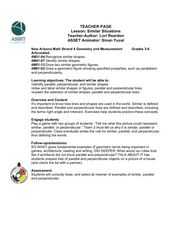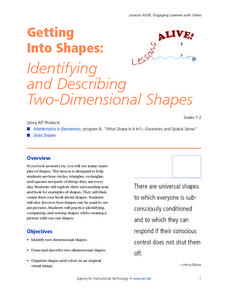Curated OER
Area of 2D Shapes Homework
In this geometry worksheet, high schoolers solve the area of 2D shapes starting with squares, rectangles, parallelograms, triangles, rhombi, trapezoids, circles, and ending with area of shaded regions. There are 20 questions.
Curated OER
Activities with 2-D shapes.
In this 2D shapes worksheet, learners complete activities such as describing features, matching edges, draw shapes, and more. Students complete 8 activities.
Curated OER
Similar Situations
Students explore intersecting lines. In this intersecting lines lesson, students investigate shapes consisting of parallel, perpendicular, and similar lines. Students investigate these lines in shapes around them.
Curated OER
2-D and 3-D Presents at Pedro's Party
Fifth graders draw 2-D and 3-D shapes. They sketch and label geometric figures with correct terminology, then explore parallel and perpendicular lines. Pupils sort and classify shapes drawn.
Curated OER
Compare 2-D Shapes
Second graders examine the attributes of two-dimensional shapes. In this geometry lesson plan, 2nd graders play a game in order to identify two-dimensional shapes and to name them.
Curated OER
Investigating Shapes in Our World
First graders explore shapes. In this geometry instructional activity, 1st graders make shapes with geo-boards, use play-dough to make three-dimensional figures, and make a shape book using pre-cut shapes.
SEN Teacher
Nets (3D Models)
Let your learners pick and create a fun shape from this custom template. Shapes range from complex geometric figures to the more common cube and prism. Each page can be labeled with your personal directions. Additional printable listed...
EngageNY
Truncated Cones
Learners examine objects and find their volumes using geometric formulas in the 21st installment of this 25-part module. Objects take the shape of truncated cones and pyramids, and individuals apply concepts of similar triangles to find...
Curated OER
Topology - The Mathematics of Distortion
In this topology worksheet, 7th graders solve and complete 12 different problems that include shapes and math distortion. First, they use the forms of capital letters as guides, stretch or bend the shape in the first column into as many...
Curated OER
Matching Directions
These abstract shapes are pointing in different directions and young scholars determine which ones are oriented the same way. For each of five starting shapes they examine a set of four identical figures pointing in various directions,...
Curated OER
Matching Directions
Which of these shapes is pointing the same way? Pre-readers examine five rows of familiar objects. The first item points to the right for each, and they must determine which of the subsequent items in each row points the same direction....
US Department of Commerce
My Dream Home
Dream big or go home. After analyzing a bar graph on the number of bedrooms in US homes derived from census data, scholars design their own dream homes. They cut out two-dimensional shapes from construction paper to create models of...
Curated OER
Making Two-Dimensional Shapes
Find the shapes that fit. Pupils explore visual discrimination in a set of geometry worksheets, which has them examine shapes that have been divided in half. They observe a set of shapes to determine which of them would fit into each...
Curated OER
Sorting 3-Dimensional Shapes
Does it have corners? Scholars sort three-dimensional figures into one of two categories based on whether or not they have corners. They look at six shapes: sphere, cylinder, cone, cube, prism, and pyramid. For each,...
Curated OER
Making Two-Dimensional Shapes
Which shapes fit? Learners practice visual discrimination using a geometry learning exercise, which has them examine shapes that have been divided in half. They observe a set of shapes to determine which of them would fit into each half...
Curated OER
Great Shapes Alive!
Compare two- and three-dimensional shapes and construct three dimensional models from two-dimensional shapes. Diagram the shapes and reflect about the process in writing.
Curated OER
Sorting 3-Dimensional Shapes
The sorting is simple here: Does this three-dimensional figure have a curved surface or not? Scholars review an example before trying this on their own with nine figures including a sphere, cylinder, prism, cube,...
Curated OER
Shapes
Fifth graders explore shapes. They recognize and name two-dimensional and three-dimensional shapes. Pupils discuss the properties and criteria for each shape they find in real life and construct a Kid Pix project using pictures of the...
Curated OER
Getting Into Shapes: Identifying and Describing Two-Dimensional Shapes
Young scholars examine their classroom to find examples of various types of shapes. After identifying and describing the various shapes, they draw as many as they can on a piece of paper. They organize them into an image based on their...
Curated OER
Recognize and Draw Shapes
What type of shape is this? Learners practice identifying shape attributes as they name a parallelogram and an oval and count the sides of a cube and a triangle. There are multiple-choice answers for the shape-name questions, so...
Curated OER
Understanding Categories of Shapes
What are these shapes? Here are four shapes with some common attributes: they each have four parallel sides and four vertices. Scholars identify a rectangle, rhombus, square, and quadrilateral. Because there is an explanation written...
Curated OER
Name the 3 Dimensional Shapes of the Objects
Here are six solid figures for learners to identify. The names are listed along the left side and the shapes pictured on the right. Each shape is shown as a familiar object instead of just a drawing. Figures include a cylinder,...
Curated OER
Using the Web to Explore Shapes
Third graders research the Internet to locate geometric designs in familiar buildings. They review shapes, solids, angles and symmetry as they research websites of familiar buildings in Louisville. They record the information they see...
Curated OER
Morning Math
Good morning, math scholars! There are 10 warm-ups here to get your class recalling past concepts and staying sharp on newer ones. Skills include writing an even and odd number sequence, subtracting money amounts, dividing shapes in...























